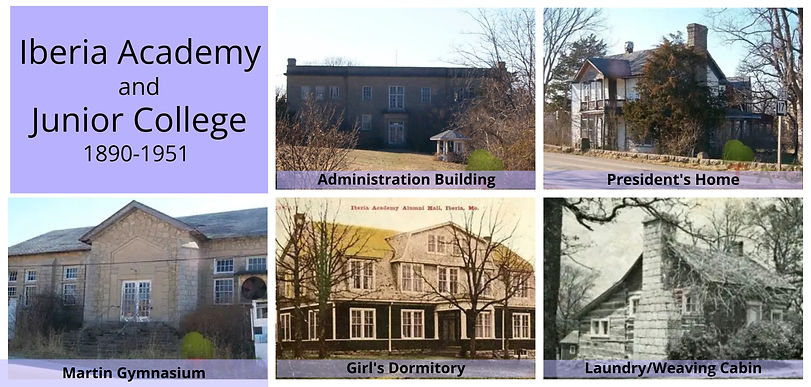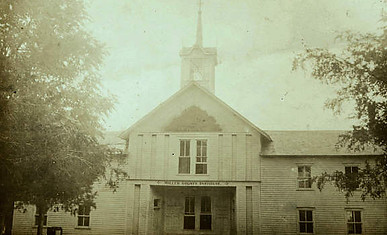

Peggy Smith-Hake's
"Window to the Past"

Historic Miller County Academies
By Kelly Warman-Stallings
Published to WTTP on 27 July 2025
Over the course of Miller County history, there have been a few early schools that offered classes of higher education but are no longer in existence today. During these early years the field of secondary education was described as " institutions of learning between the elementary school on one hand and college or university on the other".
For decades the one-room schoolhouse only offered grades 1-8. In the late 1800s, before widespread public high schools were established, the county introduced privately funded institutions that offered secondary education (grades 9-12). Granted, these facilities were subscription schools and only a small portion of the county were able to afford the rates during its early years.
The academies were scattered throughout the county, being located in Aurora Springs, Eldon, Iberia, and Spring Garden. Unfortunately, since the schools were privately operated, information and records—especially from the 1800s—are sparse and almost non-existent today, except for Iberia Academy, which is well-documented.
The information available is as follows:
Eldon Academy
Eldon Academy, founded in 1885, initially offered secondary education for students in grades 9 and 10 until ceasing operations prior to 1904. It played a pivotal role in the county's early endeavors to extend educational opportunities beyond the elementary level. In 1915, the construction of a high school building allowed for the inclusion of grades 11 and 12, further advancing local education. Following the academy's closure, its building was repurposed to house an elementary school, serving grade school students for several decades. The original academy was a two-story building featuring four classrooms.

Eldon Academy
After acquiring the academy building, Eldon Elementary expanded it in 1904 by adding eight more rooms. Children in Eldon attended the school until 1960, when the old academy building was destroyed by a fire. Unfortunately, no records have been found documenting the teachers, students, or administration. Beyond its founding and closure, little else is known about the history of Eldon Academy.
Iberia Academy
This school was established by Richard T. Marlow, a Congregational Church minister from Arkansas, who acquired the old "Normal" school, a short-lived high school in Iberia. With funding from the Congregational Church, Marlow hired Professor Byron Smith and his wife, Mabel, as teachers in 1890. In a few years, the Smiths purchased the old "Normal" school and transformed it into an institution of higher learning. It wasn’t easy, but the Smiths succeeded. Peggy Smith Hake wrote, "The academy was started on faith… a one-man idea. For years its struggle for existence was keen." Initially, the Smiths were the only teachers, but by 1926, additional educators joined, including Charles R. Brassfield, Ernest Brooks, [Mrs] Ernest Brooks, [Mrs] L. S. Diven, Edna Hammack, Myrtle Hoyer, Gerard Schultz, JoAnn Spearman, Mabel Willis, and Virgie Wynn. The school eventually became known as Iberia Academy and Junior College, marking it as the first college in Miller County.

Early subjects taught at the academy included Agricultural Science, American History, Ancient History, Biology, Botany, Chemistry, English, English Literature, Geometry, German Grammar and Literature, Greek Grammar, Latin Grammar, Math and Algebra, Rhetoric and Zoology. By 1927, the school added Citizenship, College Algebra, European History, Harmony and Psychology.
The Iberia Academy campus was the largest in Miller County during its heyday. It contained a Laundry/Weaving cabin (built c/mid-1800s), Administration building, with classrooms (built c/late 1800s), President's home (built 1888), Girl's dormitory (built 1905), and Gymnasium (1927).
In 1917, a devastating fire destroyed the Administration building, which originally housed the "Normal" school. By 1924, a new lime-rock building was constructed on the site, and over the following decades, it produced professionals such as businessmen, doctors, lawyers, preachers, and teachers. Iberia Academy and Junior College closed in 1951, with approximately 600 students graduating during its 61-year history. Today, only the Administration building remains. For the complete story of Iberia Academy by Peggy Smith Hake, check out: History of Iberia Academy.

"The Miller County Academy at Aurora Springs is an educational institution deserving prominent mention. On the bluff at Aurora Springs may be seen a large square two story brick structure with two rooms below and a large hall above, which was built after the town was founded, and at a cost of over $3000. Cook’s Hall, also an old store building, and a two story residence, had been used for the town schools, but were replaced by this structure, and among those most active in the matter were J.M. Williams, W.A. Miller, Colonel J.H. Stover, Professor W.M. Lumpkin, Drs. J.A. Stevens, Allen, Bills, Tremain, and several others. Common schools were held until 1884, when Professor H.L. Moles organized and graded the academy. Among the instructors who have been associated with him are Mrs. Moles, Miss Emma Shelton, Miss Carrie Torry, W.E. Allen, Professor Wagner (music), and Colonel J.H. Stover (law). The attendance has now reached seventy nine pupils, so that three rooms and occasionally four are used.
Miller County Academy
The academy was established at Aurora Springs by Professor Herbert L. Moles in c/1880-81. The students were educated in the higher branches of mathematics and languages. Other subjects, such as science, law and music, were later added to the curriculum. The description and history of the academy is best described in Goodrich's History of Miller County (1889):
Herbert L. Moles
Five courses are provided: Literary, scientific, law, music and commercial. The present attendance represents various parts of the county and some considerably beyond these limits. The present faculty embraces: Principal H.L. Moles, Mrs. H.L. Moles, M.L. Tremain, Colonel J.H. Stover and Miss B. Ballenger."
The exact closure date of Miller County Academy remains unknown, though it’s estimated to have been shortly after the start of the 20th century. One of its final educators was Professor E. C. McIntyre.
Miller County Institute
In 1879, Professors Herbert L. Moles and H. M. Sutton played a pivotal role in transforming a private girls' school in Spring Garden, known as Spring Garden Seminary, into the Miller County Institute, with Moles serving as Director. The school originally operated in a two-story frame building, but by 1890, the growing student population required expansion. To address this, the building was uniquely split in half, with one section moved aside to make room for a new addition in the middle that included classrooms and a large auditorium.

Original Miller County Institute

Miller County Institute after the 1890 addition,
Not long after the school's name change, the school was incorporated as a co-ed facility, allowing boys to attend. Around 1880-1881, Herbert Moles resigned his position of Director and traveled to Aurora Springs, where he started another school of higher learning (Miller County Academy). There he would continue teaching until retirement.
H. M. Sutton took the reins of the Director at Miller County Institute and hired another professor, W. A. Chalfant. Later, two more teachers were added: Jonathon and Rose Roberts, a married couple [a brother-in-law and sister to Sutton]. The Institute, which drew students from a wide area, prospered and the community of Spring Garden grew considerably that, by 1889, the population had soared to over 100.
It is unclear why the Institute closed, but in 1907 the school shut its doors for good, and students were transferred to other academic schools in the county. In 1908 the building was torn down and the Spring Garden School (elementary) was built on the same spot.
Honorable Mention: Spring Garden Seminary
The first institution of higher learning in Miller County was established at Spring Garden shortly after the Civil War in 1866. Known as Spring Garden Seminary, it was the first and only private school for girls in the county's history. According to historian Clyde Jenkins, the school initially operated from the old Christian Church, which once stood at the present northwest corner of the Spring Garden cemetery. In 1868, the community constructed a two-story frame building in the small settlement of Spring Garden. Professor William M. Lumpkin served as the first teacher and later became the seminary's director. While it is unclear whether the school offered education up to the 12th grade, two additional teachers were eventually brought on: Julia A. H. Colby from Springfield and Edward A. Henry from Pleasant Mount. By 1879, Professors H. M. Sutton of Ada, Oklahoma, and Herbert L. Moles of Clarksburg, Missouri, assumed leadership of the private school. The reasons for William M. Lumpkin's departure after 13 years of service remain unknown.